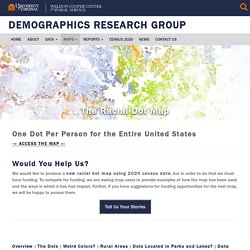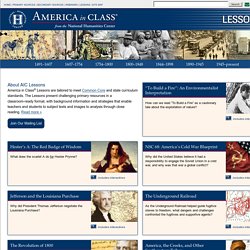

AP Human Geo. Weldon Cooper Center for Public Service. One Dot Per Person for the Entire United States Would You Help Us?

We would like to produce a new racial dot map using 2020 census data, but in order to do that we must have funding. To compete for funding, we are asking map users to provide examples of how the map has been used and the ways in which it has had impact. Further, if you have suggestions for funding opportunities for the next map, we will be happy to pursue them. Overview | The Dots | Weird Colors? Additional Resources Frequently Asked QuestionsAccess and Use Policy – describes how this map should be cited and used.Congressional Dot Map with election results.High Resolution Image of the Racial Dot Map Overview The map was created in July 2013 by Dustin Cable, a former demographic researcher at the University of Virginia’s Weldon Cooper Center for Public Service. The Dots Each of the 308 million dots are smaller than a pixel on your computer screen at most zoom levels.
Shades of Purple, Teal, and Other Colors. Gilder Lehrman Institute of American History. Lesson plans for American history & literature teachers. About AIC Lessons America in Class® Lessons are tailored to meet Common Core and state curriculum standards.

The Lessons present challenging primary resources in a classroom-ready format, with background information and strategies that enable teachers and students to subject texts and images to analysis through close reading. Read more » Join Our Mailing List includes interactives “To Build a Fire”: An Environmentalist Interpretation How can we read “To Build a Fire” as a cautionary tale about the exploitation of nature? Hester’s A: The Red Badge of Wisdom What does the scarlet A do for Hester Prynne? NSC 68: America’s Cold War Blueprint Why did the United States believe it had a responsibility to engage the Soviet Union in a cold war, and why was that war a global conflict?
HS Social Studies Colorado Sample Instructional Units. Stanford History Education Group. Geospatial. Information Literacy. Data Science. Disciplinary Literacy-Social Studies. History Methodology. Political Science Methodology. Sociology Methodology. Writing in Social Studies. New Website Makes the U.S. Constitution Searchable with Supreme Court Interpretations Throughout History. In celebration of Constitution Day, the Library of Congress is launching a new website – constitution.congress.gov – for the Constitution Annotated, the authoritative source for how the Supreme Court has interpreted the nation’s governing document over the years.

With advanced search tools and a modern user-friendly interface, the new website makes the 3,000 pages of the Constitution Annotated fully searchable and accessible for the first time to online audiences – including Congress, legal scholars, law students and anyone interested in U.S. constitutional law. “To be successful, collections must be used. That’s why I’m excited about the Constitution Annotated getting a new website. It’s a great example of what we mean when we say we’re putting our users first,” said Librarian of Congress Carla Hayden. “We’ve taken some of the most comprehensive analysis of our Constitution – the laws that make America what it is – and we’re making them easier for everyone to use.”
A Glossary of Political Economy Terms - Dr. Paul M. Johnson. Inquiry-Based Tasks in Social Studies. Many schools, both nationally and internationally, are adopting the College, Career, and Civic Life (C3) Framework for Social Studies State Standards. Some states, districts, and schools adopt the full framework and standards, and others adopt the general framework, but modify or create their own grade-level standards. An important element of the framework either way is something called the Inquiry Arc. The Inquiry Arc comprises four dimensions: “one focused on questioning and inquiry; another on disciplinary knowledge and concepts relating to civics, economics, geography, and history; another on evaluating and using evidence; and a final one on communicating and taking action.” The basic idea is that students ask or are given compelling questions and then investigate those questions, evaluate and find evidence to answer them, and communicate their answers.
For example, middle school students might be given the question “Can disease change the world?” What's Going On in This Graph?
Demographics.